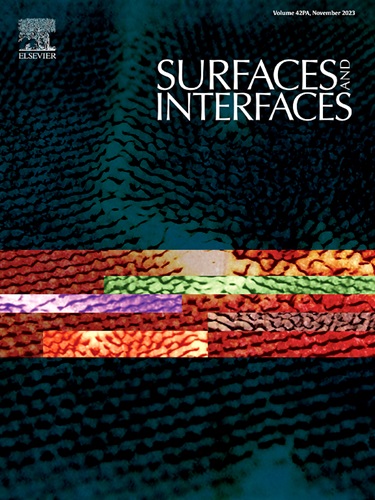Efficient removal of Congo Red Dye using MoS2-modified Mg-Al LDH Nanocomposites for Efficient Wastewater Remediation
IF 5.7
2区 材料科学
Q2 CHEMISTRY, PHYSICAL
引用次数: 0
Abstract
Recently, 2D materials have gained significant attention for their promising applications in water remediation, attributed to their exceptional structural and chemical properties. The Mg-Al LDH and MoS2/Mg-Al LDH composites were synthesized using hydrothermal method and applied for the removal of Congo Red dye from wastewater. The Transmission Electron Microscopy (TEM) and Scanning Electron Microscopy (SEM) confirms the successful formation of Mg-Al LDH hexagonal sheets on the surface of MoS2 petals like structure, while Fourier Transform Infrared Spectroscopy (FTIR) was employed to investigate the functional group present in each sample. The adsorption efficiency of Mg-Al LDH and MoS2/Mg-Al LDH composites was 56.2 and 116.41 mg/g. Adsorption studies revealed that the MoS2/Mg-Al LDH composite exhibited excellent adsorption performance compared to MgAl LDH, with a maximum adsorption capacity of 116.41 mg/g. The adsorption behavior of Congo Red dye onto Mg-Al LDH and MoS2/Mg-Al composite was better described by the kinetic pseudo 2nd order model and conformed to the Langmuir isotherm model. The thermodynamics studies reveal that the uptake of Congo Red dye on MoS2/Mg-Al LDH nanocomposite followed a spontaneous and endothermic process. The superior adsorption capability is due to the electrostatic interaction between Congo Red dye with the MoS₂/Mg-Al LDH composite surface, as well as anion exchange between the Congo Red dye and the composite. These findings suggest that MoS2/Mg-Al LDH composite is emerging as a superior candidate for practical application in removing dye pollutants from wastewater.
求助全文
约1分钟内获得全文
求助全文
来源期刊

Surfaces and Interfaces
Chemistry-General Chemistry
CiteScore
8.50
自引率
6.50%
发文量
753
审稿时长
35 days
期刊介绍:
The aim of the journal is to provide a respectful outlet for ''sound science'' papers in all research areas on surfaces and interfaces. We define sound science papers as papers that describe new and well-executed research, but that do not necessarily provide brand new insights or are merely a description of research results.
Surfaces and Interfaces publishes research papers in all fields of surface science which may not always find the right home on first submission to our Elsevier sister journals (Applied Surface, Surface and Coatings Technology, Thin Solid Films)
 求助内容:
求助内容: 应助结果提醒方式:
应助结果提醒方式:


